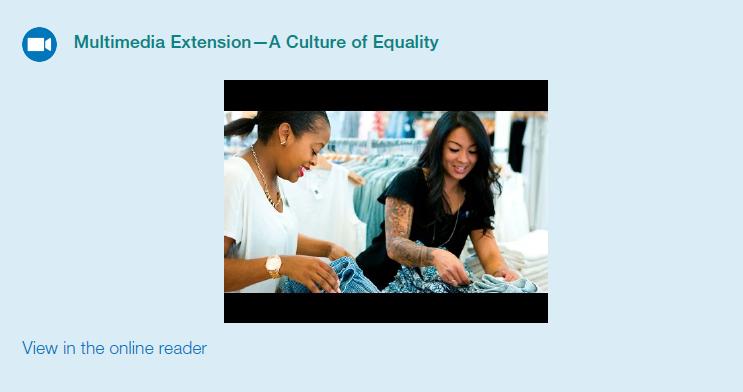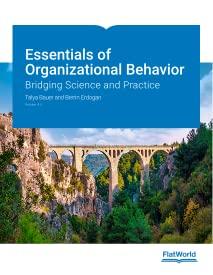The San Francisco, California based Gap Inc. is a clothing giant, with over 3,500 locations in 90
Question:
The San Francisco, California based Gap Inc. is a clothing giant, with over 3,500 locations in 90 countries, supported by 129,000 employees. The company owns well-known brands such as Banana Republic, Old Navy, Athleta, as well as Gap, and is a leader in casual men's, women's, and children's clothing. Gap was ranked by Newsweek as one of America's most responsible companies in 2020 for their commitment to doing good and giving back to their communities.
Founded over 50 years ago, the company regards its prosocial values as the key to the way the business is run. Diversity and inclusion are high among these values. For example, in 2018, the company signed the "Open to All" business pledge affirming that it would treat customers, employees, and suppliers with dignity and respect, and it would provide a welcoming and safe environment to all regardless of sex, sexual orientation, national origin, race, ethnicity, religion, and disability.
Gap was named one of the world's most diverse and inclusive companies in 2018 and 2019, ranking among the top 10 in both years. For a business catering to a diverse customer base, diversity and inclusion is critical to the bottom line of the business. As a case in point, Gucci received backlash after a design resembling blackface on a sweater. Similarly, Prada came under fire when they started selling keychains that resembled racist caricatures. It is no accident that Gap seems to avoid such missteps and fiascos. In 2018, the company formed the Color Proud Council consisting of 45 employees charged with being present in all phases of a collection's creation.
The council makes sure that marketing, merchandising, and hiring decisions are inclusive.
One of their success stories is Banana Republic's "True Hues" collection consisting of skin colored clothing. The involvement of Color Proud Council ensured that the collection was inclusive of all skin tones, with the sales significantly beating expectations.
The company uses a number of different strategies to foster diversity and inclusion. Be One Get One (BOGO) is a mentoring program aimed at developing careers of employees. The company fosters a number of different employee resource networks, such as Asians Supporting Inclusion and Awareness (ASIA), Gap Parents, and Women in Leadership (GAPWIL). The leadership team is split evenly between men and women, but there is room to improve. For example, Michele Nyrop, Chief People Officer, noted that Banana Republic moved its creative department from New York to San Francisco, which allowed them to build their team of 200 from the ground up, resulting in greater levels of diversity in their design team. In another program aimed at diversifying entry level workers called "This Way Ahead," Gap hires young adults (those between 16-24 years old) in low income neighborhoods. Applicants are selected based on their potential as opposed to past work experience, and are provided with a job coach who will show them the way and help them get integrated into the business.[4]
Despite its highly visible efforts to create an inclusive workplace, Gap's reputation in labor relations is far from spotless and shows much need for improvement. For example, in 2007, the company admitted to having inadvertently used child labor in their subcontracted production lines produced in India. Further, in 2018, a report by Global Labor Justice revealed that female workers in their Asian factories were subject to gender-based violence and abuse, with the company agreeing to investigate the issue. These examples point to the importance of infusing domestic diversity goals and initiatives into all aspects of one's business, particularly because of the necessity to manage a global supply chain ethically.
Questions
1. What do you think are the stated and unstated reason’s for Gap’s commitment to diversity and inclusion?
2. The case described Open to All, Color Proud, mentoring, employee resource networks, and This Way Ahead as some of the specific ways in which Gap manages diversity. What are your thoughts about these practices? How resource intense are they? How useful do you believe they would be in businesses in other industries?
3. How important do you think Gap’s diversity and inclusion practices are in regard to hiring and retaining its workforce?
4. In your opinion, to what extent does Gap’s influence extend beyond the boundaries of the organization to impact change in the world?
5. Gap Inc. has set a high bar for proactively cultivating a culture of diversity and inclusion and yet there are instances where these goals were not universally met, particularly in their global operations. How do you reconcile the company’s domestic efforts with the labor relations problems it encounters as part of its global supply chain? What is Gap’s obligation to address these concerns?
Step by Step Answer:

Essentials Of Organizational Behavior Bridging Science And Practice
ISBN: 9781453339244
1st Edition
Authors: Talya Bauer, Berrin Erdogan





